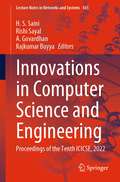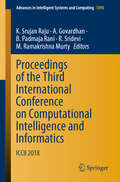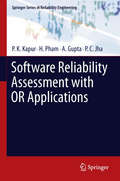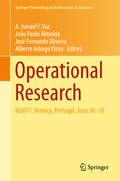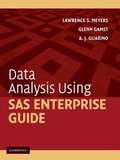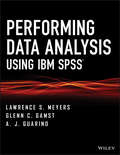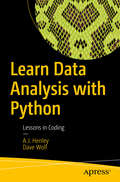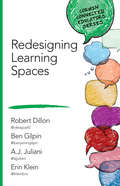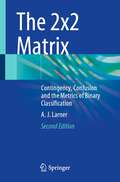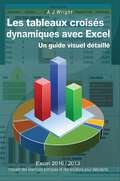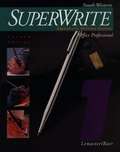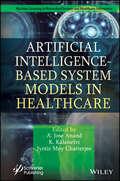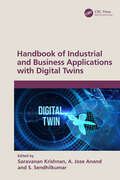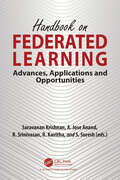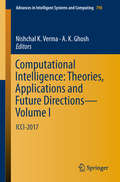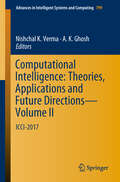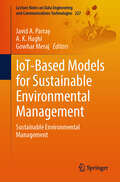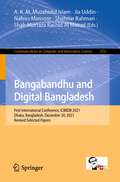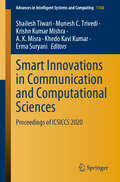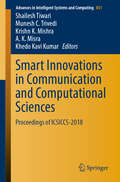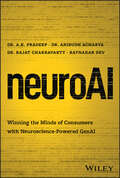- Table View
- List View
Innovations in Computer Science and Engineering: Proceedings of the Tenth ICICSE, 2022 (Lecture Notes in Networks and Systems #565)
by Rajkumar Buyya H. S. Saini Rishi Sayal A. GovardhanThis book features a collection of high-quality, peer-reviewed research papers presented at the 10th International Conference on Innovations in Computer Science & Engineering (ICICSE 2022), held at Guru Nanak Institutions, Hyderabad, India, on 16–17 September 2022. It covers the latest research in data science and analytics, cloud computing, machine learning, data mining, big data and analytics, information security and privacy, wireless and sensor networks and IoT applications, artificial intelligence, expert systems, natural language processing, image processing, computer vision, and artificial neural networks.
Proceedings of the Third International Conference on Computational Intelligence and Informatics: ICCII 2018 (Advances in Intelligent Systems and Computing #1090)
by K. Srujan Raju B. Padmaja Rani A. Govardhan R. Sridevi M. Ramakrishna MurtyThis book features high-quality papers presented at the International Conference on Computational Intelligence and Informatics (ICCII 2018), which was held on 28–29 December 2018 at the Department of Computer Science and Engineering, JNTUH College of Engineering, Hyderabad, India. The papers focus on topics such as data mining, wireless sensor networks, parallel computing, image processing, network security, MANETS, natural language processing and Internet of things.
Software Reliability Assessment with OR Applications
by Hoang Pham P. C. Jha P. K. Kapur A. GuptaSoftware Reliability Assessment with OR Applications is a comprehensive guide to software reliability measurement, prediction, and control. It provides a thorough understanding of the field and gives solutions to the decision-making problems that concern software developers, engineers, practitioners, scientists, and researchers. Using operations research techniques, readers will learn how to solve problems under constraints such as cost, budget and schedules to achieve the highest possible quality level. Software Reliability Assessment with OR Applications is a comprehensive text on software engineering and applied statistics, state-of-the art software reliability modeling, techniques and methods for reliability assessment, and related optimization problems. It addresses various topics, including: unification methodologies in software reliability assessment; application of neural networks to software reliability assessment;software reliability growth modeling using stochastic differential equations;software release time and resource allocation problems; andoptimum component selection and reliability analysis for fault tolerant systems.Software Reliability Assessment with OR Applications is designed to cater to the needs of software engineering practitioners, developers, security or risk managers, and statisticians. It can also be used as a textbook for advanced undergraduate or postgraduate courses in software reliability, industrial engineering, and operations research and management.
Computational Science and its Applications
by A. H. Siddiqi, R. C. Singh, G. D. Veerappa GowdaComputational science is a rapidly growing multidisciplinary field concerned with the design, implementation, and use of mathematical models to analyze and solve real-world problems. It is an area of science that spans many disciplines and which involves the development of models and allows the use of computers to perform simulations or numerical analysis to understand problems that are computational and theoretical. Computational Science and its Applications provides an opportunity for readers to develop abilities to pose and solve problems that combine insights from one or more disciplines from the natural sciences with mathematical tools and computational skills. This requires a unique combination of applied and theoretical knowledge and skills. The topics covered in this edited book are applications of wavelet and fractals, modeling by partial differential equations on flat structure as well as on graphs and networks, computational linguistics, prediction of natural calamities and diseases like epilepsy seizure, heart attack, stroke, biometrics, modeling through inverse problems, interdisciplinary topics of physics, mathematics, and medical science, and modeling of terrorist attacks and human behavior. The focus of this book is not to educate computer specialists, but to provide readers with a solid understanding of basic science as well as an integrated knowledge on how to use essential methods from computational science. Features: Modeling of complex systems Cognitive computing systems for real-world problems Presentation of inverse problems in medical science and their numerical solutions Challenging research problems in many areas of computational science This book could be used as a reference book for researchers working in theoretical research as well as those who are doing modeling and simulation in such disciplines as physics, biology, geoscience, and mathematics, and those who have a background in computational science.
Operational Research
by João Paulo Almeida José Fernando Oliveira Alberto Adrego Pinto A. Ismael VazThis proceedings book presents selected contributions from the XVIII Congress of APDIO (the Portuguese Association of Operational Research) held in Valença on June 28–30, 2017. Prepared by leading Portuguese and international researchers in the field of operations research, it covers a wide range of complex real-world applications of operations research methods using recent theoretical techniques, in order to narrow the gap between academic research and practical applications. Of particular interest are the applications of, nonlinear and mixed-integer programming, data envelopment analysis, clustering techniques, hybrid heuristics, supply chain management, and lot sizing and job scheduling problems. In most chapters, the problems, methods and methodologies described are complemented by supporting figures, tables and algorithms.The XVIII Congress of APDIO marked the 18th installment of the regular biannual meetings of APDIO – the Portuguese Association of Operational Research. The meetings bring together researchers, scholars and practitioners, as well as MSc and PhD students, working in the field of operations research to present and discuss their latest works. The main theme of the latest meeting was Operational Research Pro Bono. Given the breadth of topics covered, the book offers a valuable resource for all researchers, students and practitioners interested in the latest trends in this field.
Analysis of Variance Designs
by Lawrence S. Meyers Glenn Gamst A. J. Guarino Glenn Gamst Lawrence S. MeyersANOVA (Analysis Of Variance) is one of the most fundamental and ubiquitous univariate methodologies employed by psychologists and other behavioural scientists. Analysis of Variance Designs presents the foundations of this experimental design, including assumptions, statistical significance, strength of effect, and the partitioning of the variance. Exploring the effects of one or more independent variables on a single dependent variable as well as two-way and three-way mixed designs, this textbook offers an overview of traditionally advanced topics for advanced undergraduates and graduate students in the behavioural and social sciences. Separate chapters are devoted to multiple comparisons (post hoc and planned/weighted), ANCOVA, and advanced topics. Each of the design chapters contains conceptual discussions, hand calculations, and procedures for the omnibus and simple effects analyses in both SPSS and the new 'click and shoot' SAS Enterprise Guide interface.
Data Analysis Using SAS Enterprise Guide
by Lawrence S. Meyers Glenn Gamst A. J. GuarinoThis book presents the basic procedures for utilizing SAS Enterprise Guide to analyze statistical data. SAS Enterprise Guide is a graphical user interface (point and click) to the main SAS application. Each chapter contains a brief conceptual overview and then guides the reader through concrete step-by-step examples to complete the analyses. The eleven sections of the book cover a wide range of statistical procedures including descriptive statistics, correlation and simple regression, t tests, one-way chi square, data transformations, multiple regression, analysis of variance, analysis of covariance, multivariate analysis of variance, factor analysis, and canonical correlation analysis. Designed to be used either as a stand-alone resource or as an accompaniment to a statistics course, the book offers a smooth path to statistical analysis with SAS Enterprise Guide for advanced undergraduate and beginning graduate students, as well as professionals in psychology, education, business, health, social work, sociology, and many other fields.
Data Analysis Using SAS Enterprise Guide
by Lawrence S. Meyers Glenn Gamst A. J. Guarino Lawrence S. Meyers Glenn GamstThis book presents the basic procedures for utilizing SAS Enterprise Guide to analyze statistical data. SAS Enterprise Guide is a graphical user interface (point and click) to the main SAS application. Each chapter contains a brief conceptual overview and then guides the reader through concrete step-by-step examples to complete the analyses. The eleven sections of the book cover a wide range of statistical procedures including descriptive statistics, correlation and simple regression, t tests, one-way chi square, data transformations, multiple regression, analysis of variance, analysis of covariance, multivariate analysis of variance, factor analysis, and canonical correlation analysis. Designed to be used either as a stand-alone resource or as an accompaniment to a statistics course, the book offers a smooth path to statistical analysis with SAS Enterprise Guide for advanced undergraduate and beginning graduate students, as well as professionals in psychology, education, business, health, social work, sociology, and many other fields.
Performing Data Analysis Using IBM SPSS
by Lawrence S. Meyers A. J. Guarino Glenn C. GamstFeatures easy-to-follow insight and clear guidelines to perform data analysis using IBM SPSS®Performing Data Analysis Using IBM SPSS® uniquely addresses the presented statistical procedures with an example problem, detailed analysis, and the related data sets. Data entry procedures, variable naming, and step-by-step instructions for all analyses are provided in addition to IBM SPSS point-and-click methods, including details on how to view and manipulate output.Designed as a user's guide for students and other interested readers to perform statistical data analysis with IBM SPSS, this book addresses the needs, level of sophistication, and interest in introductory statistical methodology on the part of readers in social and behavioral science, business, health-related, and education programs. Each chapter of Performing Data Analysis Using IBM SPSS covers a particular statistical procedure and offers the following: an example problem or analysis goal, together with a data set; IBM SPSS analysis with step-by-step analysis setup and accompanying screen shots; and IBM SPSS output with screen shots and narrative on how to read or interpret the results of the analysis.The book provides in-depth chapter coverage of:IBM SPSS statistical outputDescriptive statistics proceduresScore distribution assumption evaluationsBivariate correlationRegressing (predicting) quantitative and categorical variablesSurvival analysist TestANOVA and ANCOVAMultivariate group differencesMultidimensional scalingCluster analysisNonparametric procedures for frequency dataPerforming Data Analysis Using IBM SPSS is an excellent text for upper-undergraduate and graduate-level students in courses on social, behavioral, and health sciences as well as secondary education, research design, and statistics. Also an excellent reference, the book is ideal for professionals and researchers in the social, behavioral, and health sciences; applied statisticians; and practitioners working in industry.
Learn Data Analysis with Python: Lessons In Coding
by Dave Wolf A. J. HenleyGet started using Python in data analysis with this compact practical guide. This book includes three exercises and a case study on getting data in and out of Python code in the right format. Learn Data Analysis with Python also helps you discover meaning in the data using analysis and shows you how to visualize it. Each lesson is, as much as possible, self-contained to allow you to dip in and out of the examples as your needs dictate. If you are already using Python for data analysis, you will find a number of things that you wish you knew how to do in Python. You can then take these techniques and apply them directly to your own projects.If you aren’t using Python for data analysis, this book takes you through the basics at the beginning to give you a solid foundation in the topic. As you work your way through the book you will have a better of idea of how to use Python for data analysis when you are finished.What You Will LearnGet data into and out of Python codePrepare the data and its formatFind the meaning of the dataVisualize the data using iPythonWho This Book Is For Those who want to learn data analysis using Python. Some experience with Python is recommended but not required, as is some prior experience with data analysis or data science.
Redesigning Learning Spaces (Corwin Connected Educators Series)
by Benjamin D. Gilpin Erin M. Klein Robert W. Dillon A. J. JulianiIt is time for the desks to lose and the children to win Bring hope, joy, and positive energy back into the daily work of the classroom. Explore how learning space design can positively impact classroom learning, the culture of a school, healthy communities, and systems and structures that make education meaningful. In this book you’ll: Find resources for redesigning spaces on a sustainable budget Support technology integration through b¬¬lended and virtual learning Hear success stories from the field The Corwin Connected Educators series is your key to unlocking the greatest resource available to all educators: other educators. Being a Connected Educator is more than a set of actions; it’s a belief in the potential of technology to fuel lifelong learning. "Redesigning Learning Spaces will take you beyond the standard classroom with ideas for creating spaces that sizzle with excitement and glow with beauty and grace." —Daniel H. Pink, author of Drive and A Whole New Mind "As a son of teachers, as a parent, and as a technologist, I recommend this book for educators who want to create a better learning experience for our children." —Gary Shapiro, author of Ninja Innovation and The Comeback
Redesigning Learning Spaces (Corwin Connected Educators Series)
by Benjamin D. Gilpin Erin M. Klein Robert W. Dillon A. J. JulianiIt is time for the desks to lose and the children to win Bring hope, joy, and positive energy back into the daily work of the classroom. Explore how learning space design can positively impact classroom learning, the culture of a school, healthy communities, and systems and structures that make education meaningful. In this book you’ll: Find resources for redesigning spaces on a sustainable budget Support technology integration through b¬¬lended and virtual learning Hear success stories from the field The Corwin Connected Educators series is your key to unlocking the greatest resource available to all educators: other educators. Being a Connected Educator is more than a set of actions; it’s a belief in the potential of technology to fuel lifelong learning. "Redesigning Learning Spaces will take you beyond the standard classroom with ideas for creating spaces that sizzle with excitement and glow with beauty and grace." —Daniel H. Pink, author of Drive and A Whole New Mind "As a son of teachers, as a parent, and as a technologist, I recommend this book for educators who want to create a better learning experience for our children." —Gary Shapiro, author of Ninja Innovation and The Comeback
The 2x2 Matrix: Contingency, Confusion and the Metrics of Binary Classification
by A. J. LarnerThis book describes, extends, and illustrates the metrics of binary classification through worked examples.Worked examples based on pragmatic test accuracy study data are used in chapters to illustrate relevance to day-to-day clinical practice. Readers will gain an understanding of sensitivity and specificity and predictive values along with many other parameters.The contents are highly structured, and the use of worked examples facilitates understanding and interpretation.This book is a resource for clinicians in any discipline who are involved in the performance or assessment of test accuracy studies and professionals in the disciplines of machine learning or informatics wishing to gain insight into clinical applications of 2x2 tables.
Les tableaux croisés dynamiques avec Excel
by A. J. WrightCe livre s’adresse à tout utilisateur d’Excel. On s’accorde à dire que soixante pour cent des utilisateurs d’Excel n’utilisent que vingt pour cent de ses capacités. Autrement dit, la plupart sont très loin de se servir de tous les outils intégrés. Parmi ces derniers, les plus féconds, et de loin, sont les tableaux et les graphiques croisés dynamiques. Bien que ces deux outils aient été la pierre angulaire d’Excel depuis plus de seize ans, ils restent les plus sous-utilisés de toute la suite MicroSoft Office. Puisque vous avez découvert ce livre, vous êtes assez informé pour en avoir déjà entendu parler, ou même les avoir utilisés à l’occasion. Vous avez compris qu’ils recèlent une puissance dont vous ne vous servez pas et voulez apprendre comment tirer parti de cette dernière pour améliorer rapidement votre productivité. À l’aide de ce simple livre, vous serez capable de générer des tableaux et graphiques croisés simples, d’augmenter votre rendement et de créer ces deux choses en quelques minutes au lieu de plusieurs heures. Dès le troisième chapitre, vous pourrez réaliser des tableaux croisés complexes munis d’analyses en profondeur avec leurs graphiques associés. Arrivé à la fin du livre, vous pourrez concevoir un système dynamique de génération de tableaux et graphiques croisés.
Superwrite: Alphabetic Writing System, Office Professional (Volume 1, 2nd Edition)
by A. James Lemaster John BaerVolume One introduces SuperWrite theory and beginning transcription principles. The step-by-step approach to writing principles guides students to alphabetic writing success. Eight lessons develop personal success factors such as goal-setting, problem-solving, time management, attendance, and promptness. Updated keyboarding style references reflect current business practices.
Artificial Intelligence-Based System Models in Healthcare
by K. Kalaiselvi A. Jose Anand Jyotir Moy ChatterjeArtificial Intelligence-Based System Models in Healthcare provides a comprehensive and insightful guide to the transformative applications of AI in the healthcare system. This book is a groundbreaking exploration of the synergies between artificial intelligence and healthcare innovation. In an era where technological advancements are reshaping the landscape of medical practices, this book provides a comprehensive and insightful guide to the transformative applications of AI in healthcare systems. From conceptual foundations to practical implementations, the book serves as a roadmap for understanding the intricate relationships between AI-based system models and the evolution of healthcare delivery. The first section delves into the fundamental role of technology in reshaping the healthcare landscape. With a focus on daily life activities, decision support systems, vision-based management, and semantic frameworks, this section lays the groundwork for understanding the pivotal role of AI in revolutionizing traditional healthcare approaches. Each chapter offers a unique perspective, emphasizing the intricate integration of technology into healthcare ecosystems. The second section takes a deep dive into specific applications of AI, ranging from predictive analysis and machine learning to deep learning, image analysis, and biomedical text processing. With a focus on decision-making support systems, this section aims to demystify the complex world of AI algorithms in healthcare, offering valuable insights into their practical implications and potential impact on patient outcomes. The final section addresses the modernization of healthcare practices and envisions the future landscape of AI applications. From medical imaging and diagnostics to predicting ventilation needs in intensive care units, modernizing health record maintenance, natural language processing, chatbots for medical inquiries, secured health insurance management, and glimpses into the future, the book concludes by exploring the frontiers of AI-driven healthcare innovations. Audience This book is intended for researchers and postgraduate students in artificial intelligence and the biomedical and healthcare sectors. Medical administrators, policymakers and regulatory specialists will also have an interest.
Handbook of Industrial and Business Applications with Digital Twins
by Saravanan Krishnan A. Jose Anand S. SendhilkumarA digital twin represents the indistinguishable digital counterpart of the physical object to simulate, monitor and test with real time synchronization. This book presents the framework and important key aspects of digital twins, including various technologies with coverage of the digital twins in various industry and business applications. It provides a background of modeling and simulation, computer sensor technology and other areas required creating the next wave of digital twins.Features: Presents exclusive material on industrial and business applications of digital twins Includes diversified digital twin applications with use cases Focuses on tools and methods for digital twins, platforms, application domains and industries Emphasizes advances and cutting-edge technologies throughout Reviews artificial intelligence (AI), fog/edge computing, industrial automation, blockchains and the Internet of Things (IoT) This book is aimed at researchers and graduate students in cloud computing, simulation, the IoT and computer engineering.
Handbook on Federated Learning: Advances, Applications and Opportunities
by S. Suresh R. Srinivasan Saravanan Krishnan A. Jose Anand R. KavithaMobile, wearable, and self-driving telephones are just a few examples of modern distributed networks that generate enormous amount of information every day. Due to the growing computing capacity of these devices as well as concerns over the transfer of private information, it has become important to process the part of the data locally by moving the learning methods and computing to the border of devices. Federated learning has developed as a model of education in these situations. Federated learning (FL) is an expert form of decentralized machine learning (ML). It is essential in areas like privacy, large-scale machine education and distribution. It is also based on the current stage of ICT and new hardware technology and is the next generation of artificial intelligence (AI). In FL, central ML model is built with all the data available in a centralised environment in the traditional machine learning. It works without problems when the predictions can be served by a central server. Users require fast responses in mobile computing, but the model processing happens at the sight of the server, thus taking too long. The model can be placed in the end-user device, but continuous learning is a challenge to overcome, as models are programmed in a complete dataset and the end-user device lacks access to the entire data package. Another challenge with traditional machine learning is that user data is aggregated at a central location where it violates local privacy policies laws and make the data more vulnerable to data violation. This book provides a comprehensive approach in federated learning for various aspects.
Computational Intelligence: ICCI-2017 (Advances in Intelligent Systems and Computing #798)
by A. K. Ghosh Nishchal K. VermaThis book presents selected proceedings of ICCI-2017, discussing theories, applications and future directions in the field of computational intelligence (CI). ICCI-2017 brought together international researchers presenting innovative work on self-adaptive systems and methods. This volume covers the current state of the field and explores new, open research directions. The book serves as a guide for readers working to develop and validate real-time problems and related applications using computational intelligence. It focuses on systems that deal with raw data intelligently, generate qualitative information that improves decision-making, and behave as smart systems, making it a valuable resource for researchers and professionals alike.
Computational Intelligence: ICCI-2017 (Advances in Intelligent Systems and Computing #799)
by A. K. Ghosh Nishchal K. VermaThis book presents selected proceedings of ICCI-2017, discussing theories, applications and future directions in the field of computational intelligence (CI). ICCI-2017 brought together international researchers presenting innovative work on self-adaptive systems and methods. This volume covers the current state of the field and explores new, open research directions. The book serves as a guide for readers working to develop and validate real-time problems and related applications using computational intelligence. It focuses on systems that deal with raw data intelligently, generate qualitative information that improves decision-making, and behave as smart systems, making it a valuable resource for researchers and professionals alike.
IoT-Based Models for Sustainable Environmental Management: Sustainable Environmental Management (Lecture Notes on Data Engineering and Communications Technologies #227)
by A. K. Haghi Javid A. Parray Gowhar MerajThis book is a testament to the dynamic intersection of environmental responsibility and the applications of IoT-based models for reader. The applications of IoT-based models, ranging from environmental sustainability and the impact of environmental pollution to human health, sustainable production, and conservation of natural resources, have long grappled with the challenges posed by waste management. It provides: A transformative solution. Sustainability and efficiency of earth protection operations. New ideas with global views and state-of-the-art results and fosters a culture of environmental stewardship. The book evaluates the environmental, economic, and social impacts of new technologies, shedding light on their potential to transform environmental facilities into models of sustainability. It provides valuable information on best practices, case studies, and practical guidance for integrating new models for environment sustainability. By addressing the varied needs of these stakeholders, it facilitates informed decision-making and promotes sustainable development with global perspectives. It will also serve as a valuable reference, inspiring innovation, fostering collaboration, and driving progress in the application of IoT technologies in environment sustainability.
Bangabandhu and Digital Bangladesh: First International Conference, ICBBDB 2021, Dhaka, Bangladesh, December 30, 2021, Revised Selected Papers (Communications in Computer and Information Science #1550)
by A. K. M. Muzahidul Islam Jia Uddin Nafees Mansoor Shahriar Rahman Shah Murtaza Rashid Al MasudThis book constitutes selected papers presented during the First International Conference on Bangabandhu and Digital Bangladesh, ICBBDB 2021, held in Dhaka, Bangladesh, in December 2021. Due to the COVID-19 pandemic the conference was partly held online. The 16 papers presented were thoroughly reviewed and selected from the 90 submissions. They present research in the areas of artificial intelligence, machine learning, image processing, blockchain technology, human-computer interaction, etc.
Smart Innovations in Communication and Computational Sciences: Proceedings of ICSICCS 2020 (Advances in Intelligent Systems and Computing #1168)
by Shailesh Tiwari Munesh C. Trivedi A. K. Misra Khedo Kavi Kumar Krishn Kumar Mishra Erma SuryaniThis book presents the latest advances and research findings in the fields of computational science and communication presented at the International Conference on Smart Innovations in Communications and Computational Sciences (ICSICCS 2020). The areas covered include smart innovation; systems and technologies; embedded knowledge and intelligence; innovation and sustainability; advanced computing; networking and informatics. It also focuses on the knowledge-transfer methodologies and the innovation strategies employed to make these effective. This fascinating compilation appeals to researchers, academics and engineers around the globe.
Smart Innovations in Communication and Computational Sciences: Proceedings of ICSICCS-2018 (Advances in Intelligent Systems and Computing #851)
by Krishn K. Mishra Shailesh Tiwari Munesh C. Trivedi A. K. Misra Khedo Kavi KumarThe book presents the latest advances and research findings in the fields of computational science and communication. The areas covered include smart innovation; systems and technologies; embedded knowledge and intelligence; innovation and sustainability; advanced computing; and networking and informatics. It also focuses on the knowledge-transfer methodologies and the innovation strategies employed to make these effective. This fascinating compilation appeals to researchers, academics and engineers around the globe.
neuroAI: Winning the Minds of Consumers with Neuroscience Powered GenAI
by A. K. Pradeep Anirudh Acharya Rajat Chakravarty Ratnakar DevIt is the most powerful revolution of this century. Neuroscience-powered GenAi enables massive impact on everything from medicine to marketing, entertainment to education, flavors to fragrances, and much more. Simply by blending cutting edge neuroscience with bleeding edge GenAi. Put humanity back at the center of GenAi. neuroAi: Winning the Minds of Consumers with Neuroscience Powered GenAi is the master guide for everyone seeking to understand this breakthrough technology; what it is, how it works, and most especially how to put it to work for competitive advantage in the marketplace. neuroAi combines learnings from advanced neuroscience with deep GenAi expertise and practical how-to's. This is a 'force multiplier,' enabling readers to gain the fullest understanding of how to apply neuroscience-powered GenAi to appeal most effectively to the hidden driver of 95% of consumer behavior: the non-conscious mind. Innovators, creatives, and corporate executives now have a blueprint of how to unleash neuroAi at scale in the enterprise. The focus is on “Top Line Growth”—build and grow revenues while exciting and winning consumers. Written by Dr. A. K. Pradeep and his team of experts at Sensori.ai, the world's only firm combining advanced neuroscience learnings with GenAi, neuroAi features a primer on neuroscience, GenAi, and the core memory structures and functions of the human brain. Dr. Pradeep's original book, The Buying Brain, broke new ground by bringing neuroscience into marketing. neuroAi takes continues this innovative journey even farther now by combining advanced neuroscience with GenAi. The book explores key topics including: How the non-conscious mind interacts with GenAi to trigger the most relevant and impactful consumer responses What are key learnings from teen brains, boomer brains, mommy brains, middle age brains that GenAi must be aware of How activating desireGPT, the brain's desire framework, strongly drives purchase intent and brand loyalty How TV shows, movies, and music can achieve higher Ratings by applying neuroscience powered GenAi to writing Scripts and Dialogs How to create Fragrance, and Flavors using neuroAi How a wide range of consumer product categories worldwide are applying neuroscience powered GenAi to foster innovation, spur sales, and build brands How to build scalable capability in neuroAi within the enterprise For business leaders and all who seek expert insight and practical guidance on how to harness this astounding technology with maximum effect for business and personal success, neuroAi serves as an inspiring and accessible resource for successful marketing in the Age of the Machine.
